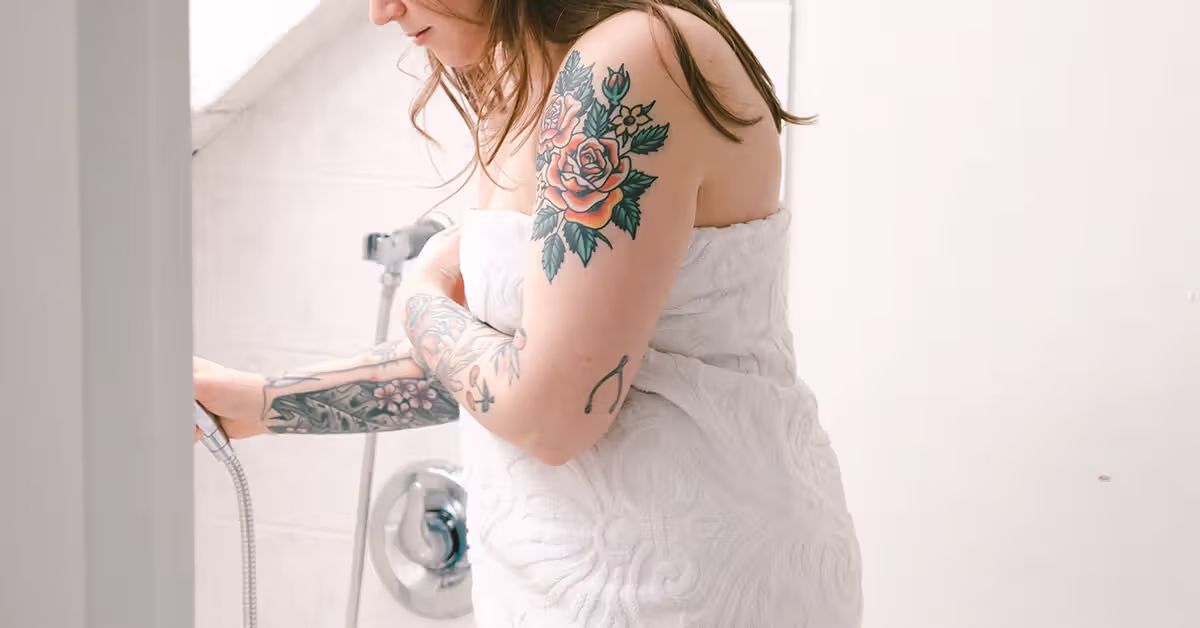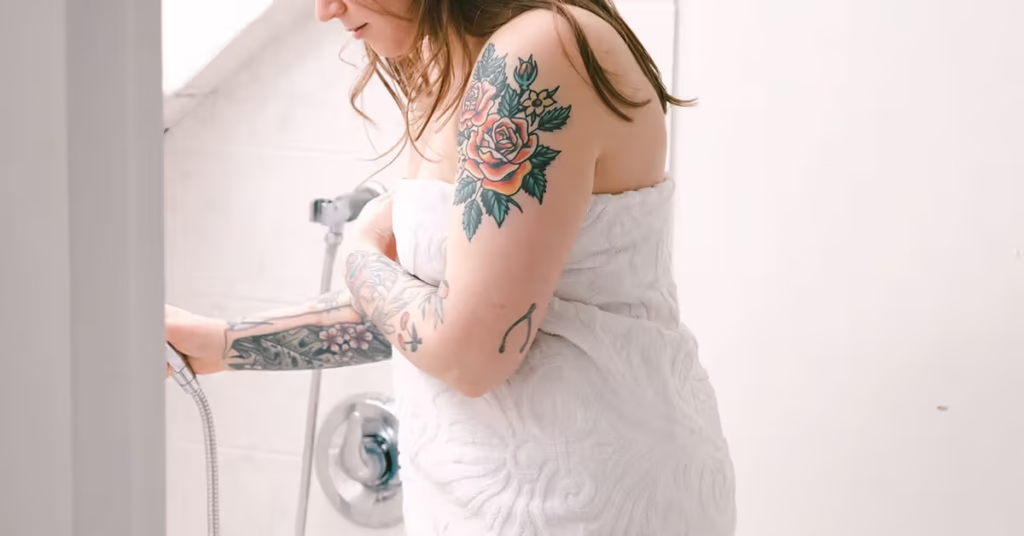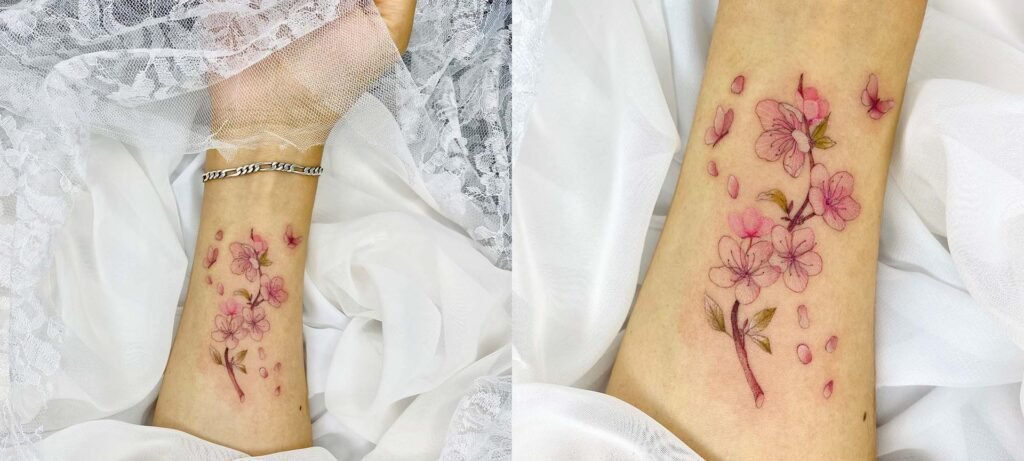If you got a new tattoo a few days ago and are noticing some bleeding, don’t panic—it’s normal. However, keeping it clean is crucial to avoid infections and ensure the best results. Gently wash the area with lukewarm water and mild, fragrance-free soap. Pat it dry with a clean paper towel—never rub. Apply a thin layer of tattoo-friendly ointment to keep it moisturized. Avoid soaking it or wearing tight clothing that might irritate the skin.
Sometimes, even with proper care, you might notice blurry lines or ink spread, which could signal a tattoo blowout. This happens when the tattoo artist injects ink too deeply, reaching the fat layer below the top layer of skin. The ink moves, creating a distorted image. While it’s not a serious problem health-wise, it greatly affects the tattoo’s appearance. If you’re experiencing this, consult a professional to discuss options to fix it afterward.
What it looks like
When you get a new tattoo, some bleeding and ink seepage in the first few days ago is normal—don’t panic. However, noticing blurry lines, ink spread, or a smudged appearance could mean trouble. If the ink looks like it’s bleeding outward, with edges appearing well outside where they should be, you might be experiencing a tattoo blowout. This happens when the tattoo artist injects ink too deeply, reaching the fat layer below the top layer of skin, causing the ink to move and create a distorted image.
While a blowout isn’t a serious problem health-wise, it greatly affects your tattoo’s appearance. To ensure the best results, avoid tight clothing, irritating the area, or soaking it. Instead, wash the area with lukewarm water and mild, fragrance-free soap, then pat dry with a clean paper towel—never rub. Apply a thin layer of tattoo-friendly ointment to keep it moisturized. If the blurring worsens, consult a professional to discuss possible fixes afterward.
What causes it?
Sometimes, tattoo blowouts occur when a tattoo artist presses too hard while applying ink, sending it below the top layers of skin where tattoos belong. Instead of staying on the skin’s surface, the ink spreads into the layer of fat, which creates that blurring effect associated with messy lines. Interestingly, tissue samples from biopsies taken on people with blowouts often show ink settling much deeper than intended—proof that technique matters just as much as aftercare.
How to fix it
If your tattoo starts bleeding, gently clean it with mild soap to prevent blood and excess ink from drying on the skin—pressing too hard can push pigment below the top layers, causing blurring or a blowout, which I’ve seen happen when aftercare isn’t handled properly.
Correct with more tattooing
If you notice your new tattoo has a blowout (where ink spreads unevenly under the skin), don’t panic. The least expensive way to minimize its appearance is camouflage—adding more tattooing to mask the blurring. A cover-up can cost between 50∗∗and∗∗400, depending on the size and extent of the issue. But here’s the catch: if you spot the problem within a few days of getting inked, you’ll need to wait up to 2 months for it to heal first.
Tattoo aftercare is important—be diligent with your routine to make sure it heals properly. A good cover-up has a positive side: you generally keep the original look while reducing the blowout. However, if it’s severe, you might need a darker or larger design than the original, leaving you with something very different from what you hoped to receive. That’s why blowout cover-ups require expertise—always choose an experienced artist with creative skills to maximize the results and avoid another mishap.
Correct with a laser
When a fresh tattoo starts bleeding, most folks panic – but what about when you notice a tattoo blowout days later? That’s when Q-switched lasers become your best friend. These machines send waves of energy that get absorbed by rogue ink particles in your skin, helping diffuse and reduce their appearance. From my experience, this treatment can leave your tattoo looking closer to what you intended, with little to no signs of mistakes – but only if you follow up with good care.
Here’s the reality: laser therapy doesn’t work for everyone, though many people find it effective for fading blowouts. You’ll typically need five or more sessions (each costing around $423 in the United States, according to the American Society of Plastic Surgeons) before the blowout becomes not noticeable. The exact number of sessions depends on your tattoo’s size, color, and age, plus your body’s reaction. Just remember – unlike getting a cover-up, this option is often more expensive and insurance companies usually not cover it since they see it as a cosmetic procedure.
Surgical tattoo removal
If you’re dealing with a severe tattoo blowout that just won’t fade, surgical tattoo removal might be your last resort. This invasive way to get rid of problematic ink requires completely getting rid of the tattoo itself – the only way to totally remove a blown-out tattoo. During the procedure, a surgeon performs an excision, carefully cutting off the tattooed skin before sewing your remaining skin back together.
While effective, there are serious considerations to include: significant scarring and extended recovery time (the smaller your removed tattoo, the less scarring you’ll notice). Unlike laser treatment, most insurance companies will usually not cover the costs since it’s considered elective. From my experience working with tattoo artists, this option should only be considered for small tattoos when all other fixes have failed.
How to prevent it
Tattoo blowouts aren’t a complication but often a mistake from lack of experience or carelessness—even on a bad day. To reduce your risk, choose a skilled artist and follow aftercare strictly.
Consider placement
Women should be extra careful since their skin is often thinner, making them more likely to experience blowouts. I always advise clients to choose spots like the legs where the skin is thickest—it heals better. Even for men, tricky areas like the top of the foot or inside the arm increase your chances of a tattoo blowout, plus they’re more painful to get tattooed. Trust experts—placement affects everything.
Choose the right artist
Even great tattoo artists can make a mistake during tattooing, but choosing someone with proven skill and experience dramatically reduces your risks of a blowout. I always tell clients to check with friends and family for recommendations first. Before committing, visit the shop – a licensed artist working in a clean, well cared for space makes all the difference for your tattoo’s healing.
When to talk with a pro
If you notice your new tattoo showing blurring within a few days, you’re likely experiencing a tattoo blowout. The first thing you should do is notify your original artist – the one who tattooed you. Many artists will offer to cover up the mistake, but it’s smart to consider all your options first. You might want someone else to do the cover-up if you doubt their skills were skilled enough, or you may rather try laser therapy if you still like the design but want to reduce the blowout’s appearance.
Before you decide on next steps, you’ll need to wait until your tattoo is fully healed before pursuing any cover-up, laser treatment, or surgical removal. When ready, contact either a reputable tattoo artist with experience in cover-ups (if going the tattoo route) or a dermatologist for professional removal options. From my experience, rushing into fixes often leads to more problems – patience pays off with tattoo corrections.
The bottom line
While tattoo blowouts can be an annoying side effect of new tattoos, you can take steps to minimize your risks – though they can’t be completely prevented. If it happens, focus on choosing the right placement and a reputable tattoo artist to help reduce the appearance. Always let your tattoo heal properly before having a professional deal with it – rushing never helps.
FAQS
What do I do if my tattoo is bleeding?
When your new tattoo starts bleeding, first stop bleeding by gently applying pressure, then clean the area thoroughly before you apply bandage. Some minimal bleeding and oozing fluid for the first 24 hours is completely normal, and may continue slightly for a few days – this is common. But if you see excessive bleeding that won’t stop, or notice the area getting red, swollen, or unusually painful, don’t hesitate to consult either your tattoo artist or a healthcare professional immediately.
Should you wipe blood off a tattoo?
Don’t worry about dried blood on your new tattoo – it’s completely normal and will naturally get off as your tattoo heals. Trying to remove it forcefully might actually damage your fresh ink, and it won’t affect the healing process at all. Just let it be and focus on proper aftercare instead.
How to fix a tattoo that bled?
When ink spreads outside your tattoo’s indented lines (what we call a bled tattoo or tattoo blowout), it’s usually due to improper tattooing technique or issues during the healing process. While this can’t be reversed, a skilled artist can make corrections through additional tattooing – either a strategic cover-up or careful touch-up to minimize the appearance of the blowout.
What can I use to clean my tattoo?
For your new tattoo, always use warm water with gentle, unscented antibacterial soap (I recommend Dr. Bronner’s or Dove) to clean properly. Avoid anything harsh like hydrogen peroxide, rubbing alcohol, or other abrasives that could irritate it. After washing, gently pat dry with a clean towel, then apply a thin layer of unscented moisturizer (Aquaphor works great) for those crucial first few days of healing.






